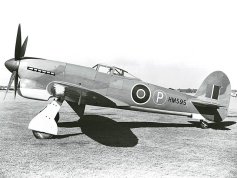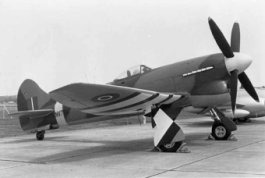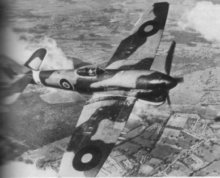
Hawker Tempest
The Hawker Tempest began on engineers' drawing boards as an improvement of the famous Typhoon with a different wing design and more power. An early flight test report by Royal Air Force pilots called the Tempest 'a manoeuvrable and pleasant aircraft to fly, with no major handling faults'. It was a robust and powerful fighter and at low altitudes it was up to 70 km/h (45 m.p.h.) faster than the Luftwaffe's Messerschmitt Bf 109 or Focke-Wulf Fw 190. In combat, pilots found that the Tempest was able to take devastating hits from gunfire and still remain in the air.
Tempest began service in April 1944 and were active during the build up to the Normandy invasion two months later. Pitted against the V-1 flying bomb, Tempest pilots were credited with shooting down 638 of the RAF's total of 1,771 destroyed. Tempests supported the Allied advance across Europe and fought the Messerschmitt Me 262 jet fighter successfully, shooting down at least 11.
After the war Tempest Vs Continued in service with British Air Force of Occupation (BAFO) squadrons until they were replaced by Tempest Mk IIs and Vampires. The tropicalised, more powerful Tempest Mk VI was also operated by the RAF in the Middle East. Centaurus-powered Tempest Mk IIs entered service in 1946 and were flown by squadrons based in Germany, Hong Kong, India and Malaya until they were replaced by Hornets in 1951. The Indian and Pakistan air forces also flew Tempest Mk IIs.
The Hawker Tempest was a big, powerful fighter developed to follow the better-known Typhoon. With a huge engine,'bubble' canopy and high performance, the Tempest proved to be a tremendous weapon for the Allies in the war in Europe. This fine fighter took on many challenges, but is best remembered for intercepting and shooting down V-1 'flying bombs' that were launched against England in 1944 and 1945.
 |
 |
 |
| This Mk VI was a tropicalised version of the Mk V with the Sabre V engine and a bigger radiator. |
During 1944-45 RAF Tempest Mk Vs were successfully engaged in ground attack, train busting, destroying V-1s and supporting the Allied assault through Belgium and Holland. |
A new, thin elliptical, laminar flow wing was produced for the Tempest. Sdyney Camm, the designer, said he only designed this wing shape because of the RAF's fixation with the success of the Spitfire. |
|
Hawker Tempest (Technical Specification) |
| Role |
Single-seat fighter and fighter bomber |
| Manufacturer |
Hawker |
| Maximum Speed |
686 kmh (425 mph) |
| Maximum Range |
1,191 km (740 miles) |
| Ceiling |
11,125 meters (36,500 feet) |
Weight
Empty
Maximum Takeoff |
4,082 kg (8,980 lbs)
6,142 kg (13,512 lbs) |
Dimensions
Wingspan
Length
Height
Wing Area |
12.50 meters (41 ft)
10.26 meters (34 ft)
4.90 meters (16 ft)
28.06 square meters (302 sq ft) |
| Engines |
One Bristol Centaurus Mk V 24-cylinder piston engine (Mk II) which provides 1,766-kW (2,366-hp)
One Napier Sabre IIA/B 24-cylinder 'H' piston engine (Mk V) which provides 1,626-kW (2,180-hp) |
| Armament |
Four 20 mm (0.79 in) cannon plus two 227 kg (500 lbs) or
Two 454 kg (1,000) bombs or
Eight 27 kg (60 lbs) rocket projectiles |
Photo Gallery
Click here to submit your photo
| Have A Passion For Aircraft? |
Subscribe to our 14 series FREE newsletter
delivered weekly on World War 2 Aircraft factfile... |
| NB:- We hate spam as much as you do, so your email address will NEVER be shared with or sold to anyone else. That's a Guarantee. |
|
|






